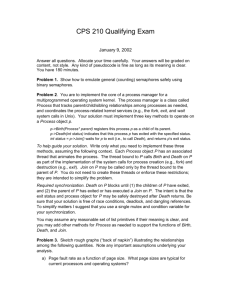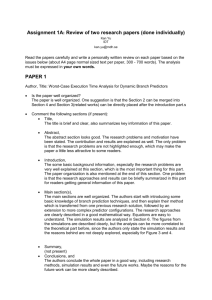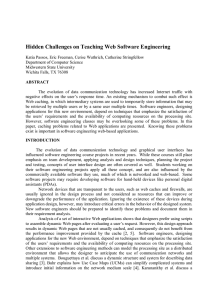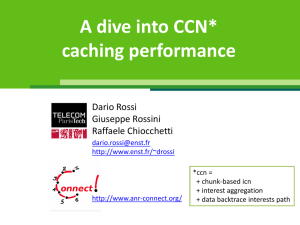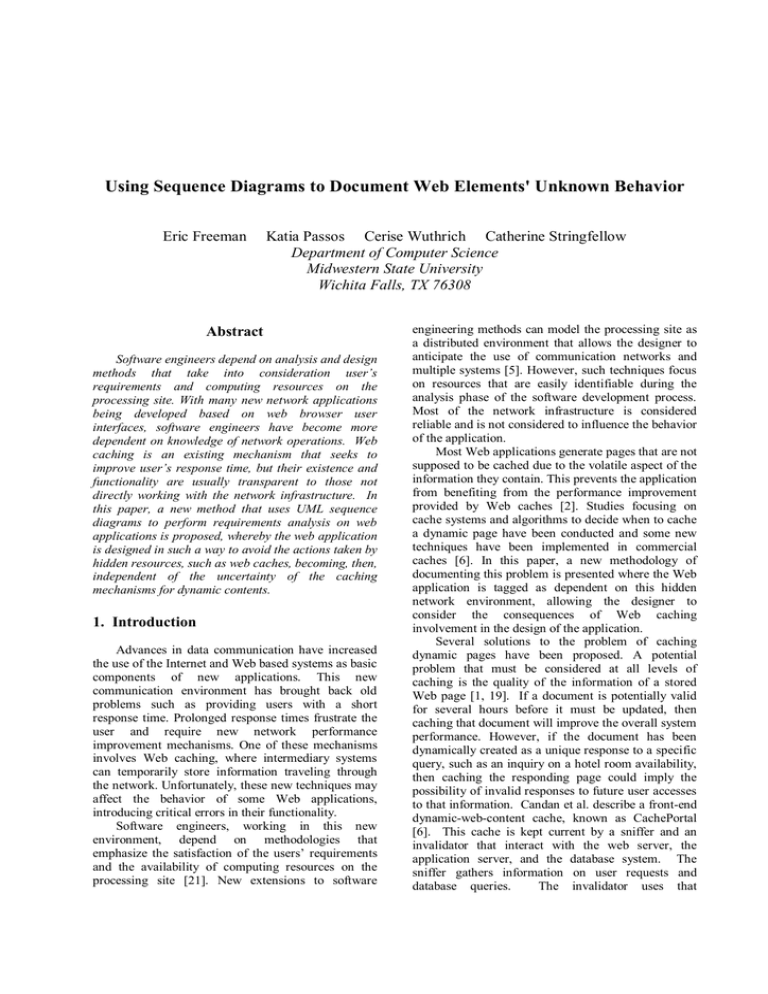
Using Sequence Diagrams to Document Web Elements' Unknown Behavior
Eric Freeman
Katia Passos Cerise Wuthrich Catherine Stringfellow
Department of Computer Science
Midwestern State University
Wichita Falls, TX 76308
Abstract
Software engineers depend on analysis and design
methods that take into consideration user’s
requirements and computing resources on the
processing site. With many new network applications
being developed based on web browser user
interfaces, software engineers have become more
dependent on knowledge of network operations. Web
caching is an existing mechanism that seeks to
improve user’s response time, but their existence and
functionality are usually transparent to those not
directly working with the network infrastructure. In
this paper, a new method that uses UML sequence
diagrams to perform requirements analysis on web
applications is proposed, whereby the web application
is designed in such a way to avoid the actions taken by
hidden resources, such as web caches, becoming, then,
independent of the uncertainty of the caching
mechanisms for dynamic contents.
1. Introduction
Advances in data communication have increased
the use of the Internet and Web based systems as basic
components of new applications. This new
communication environment has brought back old
problems such as providing users with a short
response time. Prolonged response times frustrate the
user and require new network performance
improvement mechanisms. One of these mechanisms
involves Web caching, where intermediary systems
can temporarily store information traveling through
the network. Unfortunately, these new techniques may
affect the behavior of some Web applications,
introducing critical errors in their functionality.
Software engineers, working in this new
environment, depend on methodologies that
emphasize the satisfaction of the users’ requirements
and the availability of computing resources on the
processing site [21]. New extensions to software
engineering methods can model the processing site as
a distributed environment that allows the designer to
anticipate the use of communication networks and
multiple systems [5]. However, such techniques focus
on resources that are easily identifiable during the
analysis phase of the software development process.
Most of the network infrastructure is considered
reliable and is not considered to influence the behavior
of the application.
Most Web applications generate pages that are not
supposed to be cached due to the volatile aspect of the
information they contain. This prevents the application
from benefiting from the performance improvement
provided by Web caches [2]. Studies focusing on
cache systems and algorithms to decide when to cache
a dynamic page have been conducted and some new
techniques have been implemented in commercial
caches [6]. In this paper, a new methodology of
documenting this problem is presented where the Web
application is tagged as dependent on this hidden
network environment, allowing the designer to
consider the consequences of Web caching
involvement in the design of the application.
Several solutions to the problem of caching
dynamic pages have been proposed. A potential
problem that must be considered at all levels of
caching is the quality of the information of a stored
Web page [1, 19]. If a document is potentially valid
for several hours before it must be updated, then
caching that document will improve the overall system
performance. However, if the document has been
dynamically created as a unique response to a specific
query, such as an inquiry on a hotel room availability,
then caching the responding page could imply the
possibility of invalid responses to future user accesses
to that information. Candan et al. describe a front-end
dynamic-web-content cache, known as CachePortal
[6]. This cache is kept current by a sniffer and an
invalidator that interact with the web server, the
application server, and the database system. The
sniffer gathers information on user requests and
database queries.
The invalidator uses that
information to send messages to the cache to discard
pages that were affected by changes in the database.
However, these changes in the system require the
developer to have control not only on the application
system but also on the network implementation, which
is not always possible if one considers the Internet as
its communication media.
Web
application
designers
depend
on
methodologies that focus on users’ requirements and
computing resources on the processing site. These
methodologies are the subject of several research
efforts. For example, Fernandez et al. describe a
language to specify a site’s content and its HTML
representation [10]. Processing sites can also be
modeled as distributed environments that allow the
representation of communication networks and
multiple systems. In this context, Bouguettaya et al.
discuss how to describe data sharing [4]. Buhr
proposes a simplification of system representation,
introducing initial information on the network medium
[5]. Karunanithy et al. present a scenario for mobile
users with an assortment of end-user devices [12].
Mori, Paterno and Santoro describe a tool that
represents tasks in detail and replicates their dynamic
behavior [14]. However, such techniques are
applicable to systems and resources that are easily
identified either by the user or by the designer.
Other studies are oriented towards the application
functionality and do not consider the possibility of
Web caches impacting the behavior of the application.
Pertriu, Shousha, and Jalnapurkar discuss the use of an
UML description of a telecommunication product
[17]. Petriu and Woodside report weaknesses in an
analysis that includes lack of knowledge and other
aspects using model building from software design
products [18]. Bernardi and Santucci propose Web
based hierarchical model libraries and reusable
designs using an object-oriented architecture [3].
Knight and Dai also work towards an object-oriented
Web applications approach [13]. Cloyd emphasizes
human factor methods in use-driven processes [8].
Constantine and Lockwood focus on user interface
design and usability issues applicable to Web centric
systems [9]. Hendrickson and Fowler also concentrate
their study on user interaction and hosts [11]. The
results of this study affect the way that applications are
written in the implementation phase of the software
project. The proposed methodology has the benefit of
alerting the designer to unpredictable behavior of the
application when implemented in Internet based
systems.
The next section introduces the concept of web
caching and software engineering scenarios, followed
by a discussion on problems already identified with
the design and implementation of interactive web
applications. The subsequent sections propose a new
approach to represent the application scenarios.
2. Background
The concept of Web caching is very similar to the
traditional definition of cache memory. In a network
environment, Web caches are placed close to the user.
Figure 1 shows a representation of possible locations
for a Web cache according to a hierarchical structure.
In such a caching structure, the Web browser
maintains a copy of the most recently visited Web
pages in the local (user) system. When a new Web
page request is initiated, the browser attempts to fulfill
the request from the pages located within its cache.
When the requested page is not found in the local
cache, a request to the Web server is initiated.
regional cache
Firewall
(institutional
cache)
Internet
Browser
(local cache)
server
caches
Web applications that require user interaction to
generate new information, such as a flight reservation
system or an online bookstore, are usually prototyped
by using scripting languages. These prototypes may
become operational products if considered efficient
and able to provide the necessary functionality to the
system. One of the most used scripting languages is
PHP (PHP Hypertext Preprocessor) [20]. The
response web page is coded in HTML for the more
traditional Wired Web and eventually in wireless
markup language (WML) when communicating with
wireless devices such as a cell phone [7, 22].
Web caching is usually transparent to the user and
to the application designer. However, the application
designer, usually, will not have enough information to
establish if a web cache is involved in the system
operation. In order to understand the consequences of
ignoring the information on web caching, assume a
cell phone user arrives at the airport and finds out that
her flight was cancelled. By accessing the Internet
through the cell phone, such a user can immediately
re-schedule the flight (as seen in some TV
commercials). In order to do that, the user needs to
find a different flight, check for seat availability and
make a reservation. A second passenger, with the
same problem, borrows her cell phone and without
disconnecting tries to re-schedule his flight to the
same flight on which she got the new reservation. A
typical system should provide an answer for the
second user that shows at least one less seat in the
availability chart of the new flight (the seat reserved
by the first user). However, if the caching system
resident in the cell phone decides to store dynamic
web pages, the second user may end up getting exactly
the same answers as the first user, which would imply
that both reserved the same seat (also assumed here is
that no special dynamic caching technique was used to
invalidate the pages after they were stored).
A simple solution exists to avoid the problem.
Web caching systems store pages by their URL and
should be able to identify a dynamic page when the
URL includes any form of parameter passing. For
example, http://www.hotelslct.com/res/Inf?htl=34&pd=1 is
a modified URL from an actual request for a hotel
reservation system. The htl and pd parameters should
provide the necessary information about the dynamic
nature of the access. However, if the user is just
requesting directory information, then even if the page
is dynamically created, the use of a cached version
does not invalidate its contents. Therefore, one must
consider that some dynamic pages may be cached
without any negative effect in the application.
3. Requirement Analysis
When developing applications involving network
data communications, software engineers may try to
cover all aspects of the system components by
recording in their requirement analysis typical
behavior of the network that might interfere with the
functionality of the system being designed. While this
may be the solution for multiple problems, it only
works when the components are entirely developed as
part of the system, i.e. no off-the-shelf browsers and
no external network structure is involved. However,
many systems are currently being developed on top of
the Internet and commercial browsers in order to
implement the so-called enterprise systems. These new
systems depend on the standardization of those offthe-shelf components.
Web caching and firewalls are two examples of
recent technology added to the networks in order to
improve performance and security. Such systems have
the characteristic of being configured by their
administrators and those administrators usually are not
associated with the enterprise system being designed.
This situation allows changes in the system that could
affect the behavior of the application. A simple
solution with respect to the web-caching problem,
which would work according to the HTTP definition,
is the use of HTTP header parameters to specify the
dynamic responses as non-cacheable. While this is
probably the best approach, it still assumes that any
cache system will be correctly configured, working
under the expected HTTP standards. A more trivial
solution would be to add to the list of parameters the
time and date of the request, making each request
unique with respect to the cache screening mechanism.
The server side script would disregard the date/time
information, if not necessary to the application, and
proceed by preparing and sending a new answer.
Unfortunately, this solution increases the amount of
data being transmitted by the system. In any of these
cases, the software engineering methodology used to
document the requirement analysis must be able to
indicate the possibility of such problems so the
development team could follow those specifications in
order to implement a reliable system.
A common technique used in describing the
results of a requirement analysis is the use of scenarios
or use cases. A sequence diagram can represent the
behavior of a single use case [11]. In a sequence
diagram there are boxes at the top of the diagram that
represent objects. Each object has a lifeline, which is
represented by a dashed vertical line underneath it.
Between these objects there are actions taken
(messages are passed), which displays their
interactions. Each action is shown in order of their
expected occurrence, from top to bottom and may
have labels included for the name of the action. In this
diagram an activation box may be included to show
that the object is active. Take into consideration
figure 2. A student who has been accepted to a
university does not have the money for tuition. He or
she goes to a local bank and applies for a loan. The
student is granted the loan from the bank, and then he
Bank
Student
ApplyForLoan()
Receive loan
TuitionStatus: Check()
PayTuition(loan)
Receive receipt
University
4. Preventing web cache influences
In this study, in order to verify the possibility of
errors, an online wireless testing application was
Client
se
wt
ait
Network Server
normal
C
timeout
client
ca
nc
el
or she checks on the cost of the tuition. The student
goes to the university to pay the tuition with the loan
and in return receives a receipt.
An alternative to this procedure is the Use Case
Maps (UCM) technique, proposed by Buhr [5]. A Use
Case Map is a scenario-based notation that attempts to
simplify and generalize how the structure of a
complex system and the behavior of the system are
intertwined. The focus is on the big picture. The Use
Case Map lacks formality, does not pay attention to
details, and is lightweight. UCMs are meant to help
stimulate thinking, discussion, inference, and
visualization about a system. The core notation of a
UCM involves three fundamental elements:
a. wiggly lines representing scenario paths
b. rectangular boxes representing runtime components
c. x’s representing responsibility points
Also included are start and end points, forks, and
joins.
To use and read a UCM, it is suggested that a
person place a token (either mentally or literally) on
each start point and then move each token along its
path. If paths cross intercomponent gaps, this infers
intercomponent communication requirements. The
UCM thus provides a framework for reasoning about
such
intercommunication
without
requiring
commitment to details.
Figure 3 illustrates a network transaction. The
component stacks (for client and server) indicate that
many concurrent yet independent transactions may be
in progress at once. There is a decision to be made
concerning how transaction-path concurrency will be
implemented. Yet this diagram does not concern itself
with the details of that decision. It merely provides a
context for thinking about the decision. The figure also
illustrates the “behavior structure” for providing
transaction completion in case of network failure (as
indicated by the ground symbols). This UCM shows
two routes from A to B. One is the result of a timeout
and the other shows a normal transaction completion.
In either route, the AND-fork mandates that a timer is
set and the transaction must wait for cancellation of
the waiting condition whether through normal
transaction completion or a timeout.
Ordinary transaction completion prompts a cancel
responsibility that cancels the waiting condition and
the timer. This is a typical example of how to
document the standard behavior of the network in such
a way to have it documented for the software being
developed.
developed. A database was created containing all
information about the tests including name, objectives,
questions, answer choices, and feedback responses. A
script language was used to connect the database to the
user. A portion of the experimental output on a generic
cell phone is shown in figure 4. This application
allows a student to take multiple-choice tests. The
questions are displayed one at a time, along with
answer choices. Each time the student answered a
question, the answer was saved and the next question
along with answer choices was retrieved. The
application continued to display questions until it was
determined that all questions for a particular test had
been presented. At that time, the application showed
each question number, the student’s response to the
question, and if the answer was correct or not. If the
student answered incorrectly, a brief feedback
response was presented. After all answer choices and
feedbacks were displayed, the student’s test score was
shown.
!
%
"
& "
#
$
$ '() *+
"
The application was tested using cell phone and
PDA simulators. Some of the browsers assumed that
any page was cacheable and therefore, it retrieved
from the cache dynamic pages that passed exactly the
same parameters. After an initial run of a particular
test with 20 questions, there were 25 server hits. After
taking the test once, the same test was taken again
with exactly the same answers. During this instance
of test taking, there were 0 server hits or 100% cache
hits. To further examine the caching process with the
simulator, the test was taken once again, supplying all
correct answers (score of 100) and without
disconnecting before taking the test a second time.
Before taking the test the second time, the database in
the Web server was updated and the correct answer
choice on question 1 was changed. Taking the test
again with the same 20 answers as the first time
should result in a score of 95. Actual results show it
still scored 100. Other simulators used seem not to
cache any page.
Figure 5 shows a sequence diagram representing
the most appropriate scenario for this testing
application. It shows a non-initial run of the system in
a multi-user environment, where questions could be
cached and where answers were supposed to bypass
the cache. While this scenario could be considered a
reasonable tool in the development of the application,
it does not work because the development team may
not have access and control on how the cache
operates. Therefore, the simple idea that there is a
cache in the system is just a sign of trouble for the
application. The correct idea to be documented in the
requirement analysis diagram is the existence of an
extraneous component, which cannot be controlled by
the application.
cache
user
server
StartSession()
TitleScreen
question 1: request()
question 1
answer()
score
*question: continue()
question
(
,
""
Figure 6 shows the proposed modification to the
scenario diagrams where an interruption in the flow of
the data indicates the intervention of elements external
to the application system being developed. This
interruption could be labeled or not, depending if all
the elements are known, in such a way to allow future
project management decisions on replacing those
elements by in-house developed components, which
would guarantee a standard behavior, as seen in figure
6. This solution is similar to the transactor proposed
by Buhr [5]. However, the transactor assumes that the
designer has the knowledge on its functionality.
user
server
-browser
-cache
-firewall
-network
StartSession()
TitleScreen
question 1: request()
?
question 1
answer()
score
*question:continue()
question
*
,,
After receiving the diagram shown in figure 6, a
software engineer working on an implementation
team, would need to analyze all possible behaviors
that could be expected from the unknown component
interference. Assuming the designer has no network
experience, he or she could still plan for the following
situations:
A. From the user’s (client) side:
1. messages do not arrive at the server
2. messages arrive in duplicate
3. erroneous messages are sent to the server by the
unknown component
4. messages reach the server with success
B. From the server side:
1. pages do not arrive to the user’s system
2. pages arrive in duplicate at the user’s system
3. pages are generated by the unknown component
4. pages arrive successfully
With all these options planned, the system can be
developed in such a way to provide the expected
reliability. In this study experiment, several options
were tested including the use of cache-time expiration
parameters defined in HTTP, time tags generated in
the access of dynamic pages, no action or disregarding
the existence of the unknown element, etc. Exhaustive
tests have shown that when the correct actions were
taken the system behaved according to the user initial
requirements.
5. Conclusion
While Web caching seems to be fully transparent
to the user, those systems may interfere with the
behavior of an application and introduce invalid
information in the flow between client and server
machines. Simple mechanisms already available in the
network protocols that allow the developer to
guarantee the correctness, in any circumstance, of the
behavior of the application with respect to web
caching are costly in performance. The correct
documentation of the system requirements becomes an
essential tool for the developer to be able to formulate
distinct solutions to the target problem. The use of
sequence diagrams to represent scenarios is a common
visual tool available to UML users. The introduction
of a black box in the sequence representation will
allow the development team to communicate the
existence of system elements out-of-control of the
project, requiring special handling in order to maintain
the system reliability.
6. Acknowledgements
This work was partially supported by the Texas
Advanced Research Program under Grant No. 0036560108b-2001.
Openwave and the Openwave logo are trademarks
of Openwave Systems Inc. All rights reserved.
7. References
[1] M. Arlitt, L. Cherkasova, J. Dilley, R. Friedrich and T.
Jin, “Evaluating Content Management Techniques for Web
Proxy Caches,” ACM SIGMETRICS Performance
Evaluation Review, Vol. 27, No. 4, March 2000, pp. 3-11.
[2] G. Barish and K. Obraczka, “World Wide Web Caching:
Trends and Techniques,” IEEE Communications, Vol. 38,
No. 5, 2000, pp. 178-184.
[3] F. Bernardi and J. F. Santucci, “Model Design Using
Hierarchical Web-Based Libraries,” Proc. of the Design
Automation Conference, June 2002, pp. 14-17.
[4] A. Bouguettaya, B. Benatallah, L. Hendra, M. Ouzzani
and J. Beard, “Supporting Dynamic Interactions among
Web-Based Information Sources,” IEEE Transactions on
Knowledge and Data Engineering, Vol. 12, No. 5, May
2000, pp. 779-801.
[5] R. J. A. Buhr, “Use Case Maps as Architectural Entities
for Complex Systems,” IEEE Transaction on Software
Engineering, Vol. 24, No. 12, 1998, pp. 1131-1155.
[6] K. S. Candan, W.-S. Li, Q. Luo, W.-P. Hsiung, and D.
Agrawal, “Enabling Dynamic Content Caching for
Database-Driven Web Sites,” Proceedings of the ACM
SIGMOD 2001, Santa Barbara, CA, Vol. 30, No. 2, May,
2001, pp. 532 - 543.
[7] E. Castro, HTML for the World Wide Web, 4th Ed.,
Peachpit Press, Berkeley, CA, 2000.
[8] M. H. Cloyd, “Designing User-Centered Web
Applications in Web Time,” IEEE Software, Vol. 18, No.1,
January/February 2001, pp. 62-69.
[9] L. L. Constantine and L. A. D. Lockwood, “UsageCentered Engineering for Web Applications,” IEEE
Software, Vol. 19, No. 2, 2002, pp. 42-50.
[10] M. Fernandez, D. Florescu, A. Levy and D. Suciu,
“Declarative Specification of Web Sites with Strudel,” in the
Very Large Data Base Journal, Vol. 9, No. 1, 2000, pp. 3855.
[11] E. Hendrickson and M. Fowler, “The Software
Engineering of Internet Software,” IEEE Software, Vol. 19,
No.2, March/April 2002, pp.23-24.
[12] K. Karunanithi, K. Haneef, B. Cordioli, A. Umar and R.
Jain, “Building Flexible Mobile Applications for Next
Generation
Enterprises,”
Proc.
of
the
IEEE
Academia/Industry Working Conference on Research
Challenges, Buffalo, NY, April 2000, pp.127-132.
[13] A. Knight and N. Dai, “Objects and the Web,” IEEE
Software, Vol. 19, No. 2, March/April 2002, pp.51-59.
[14] G. Mori, F. Paterno and C. Santoro, “CTTE: Support
for Developing and Analyzing Task Models for Interactive
System Design,” IEEE Trans. on Software Engineering, Vol.
28, No. 8, 2002, pp. 797-813.
[15] Openwave Mobile Access Gateway Edition, Openwave
Systems, Inc., Redwood City, CA, Feb. 2002, pub.
DSMAG-R5.1-004.
[16] Openwave SDK WAP Edition 5.0, Openwave Systems,
Inc., Redwood City, CA, 2001, pub. DSSDK-R1-001.
[17] D. Petriu, C. Shousha and A Jalhapurkar, “Architecture
Based
Performance
Analysis
Applied
to
a
Telecommunication System,” IEEE Transactions on
Software Engineering, Vol. 26, No. 11, November 2000,
pp.1049-1065.
[18] D. Petriu and M. Woodside, “Analyzing Software
Requirements Specifications for Performance,” Proceedings
of the Workshop on Software and Performance WOSP ’02,
Rome, Italy, July 2002.
[19] L. Rizzo and L Vicisano, “Replacement Policies for a
Proxy Cache” IEEE/ACM Transactions on Networking, Vol.
8, No. 2, April 2000, pp. 158-170.
[20] A. Royappa, “The PHP Web Application Server,” The
Journal of Computing in Small Colleges, Vol. 17, No.4,
March 2000, pp. 201-211.
[21] M. Fowler and K. Scott, UML Distilled, 2nd ed.,
Boston, MA: Addison-Wesley Publ. Company, 2000.
[22] Wireless Application Protocol WAP 2.0. Technical
White Paper, WAP Forum, Jan. 2002.


